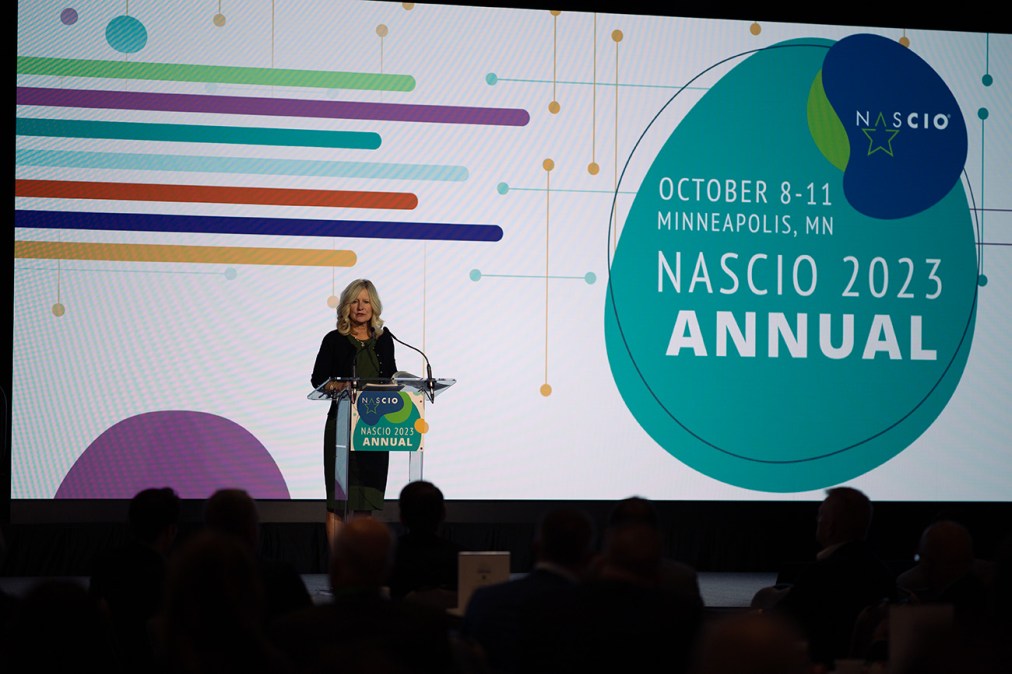Generative AI, financial models top of mind for state CIOs in NASCIO’s annual survey

The National Association of State Chief Information Officers on Tuesday published the results of its annual member survey, highlighting changes in state technology enterprises that include shifting financial models and a bubbling interest in generative artificial intelligence.
The report draws on interviews and survey responses from top technology officials in 49 states, Washington D.C. and the U.S. Virgin Islands. (South Carolina was the only state to not participate.) The report notes that state CIO offices now have a median budget of $132 million and help administer an “unprecedented” level of federal funding for technology projects, including from the Coronavirus Aid, Relief and Economic Security Act, the American Rescue Plan and the Infrastructure Investment and Jobs Act.
In addition to responding to questions about cybersecurity, legacy modernization and cloud services, state CIOs reported using an array of financial models to fund both new and ongoing technology initiatives, with most states adopting a “hybrid” approach that combines two or more models. Such hybrid approaches include a combination of “chargeback” models that include billing state agencies, relying on general funds and agency assessment models.
Only eight states reported that they rely entirely on a chargeback model, but chargeback is a major source of funding for most states that use it. Among states that reported using chargeback, about three-quarters get more than half of their funding from through that source, the survey found.
For some CIOs, federal funding makes a sizable portion of their funding — 17% of CIOs said federal funding is between 41-80% of their revenue and a third said it’s 21-40%.
State CIOs have told StateScoop in past interviews that a lack of flexibility in funding models can make it difficult to plan large-scale IT modernization projects that stretch over many years and can be unpredictable. One CIO advocating for a hybrid financial model told NASCIO: “[We should have] chargeback for services, but a general fund allocation for innovation, research and development and similar activities would help IT be much more proactive.”
New Hampshire CIO Denis Goulet told StateScoop that his state uses three financial models: a “non-lapsing fund” in which his agency over-collects for initiatives with recurring costs, direct chargeback for agency-specific projects and a formulaic model. Goulet said the formulaic model is complicated and opaque and that he favors using the non-lapsing fund model.
“That gives you the ability to invest down the road as things age out,” he said. “That’s working really well for some of the stuff you have to replace every five or six years, as long as you’re not over-collecting too much.”
Generative AI as ‘gamechanger’
As in past annual surveys, NASCIO this year asked CIOs which new technologies they believe will have the greatest impact on state government in the years ahead. Fifty-three percent of respondents named generative AI, a technology that states have in recent months been scrambling to assess. Many have created task forces assigned to understand how the technology could aid or hinder operations, and others have drafted policies to ensure responsible usage.
One CIO told NASCIO that generative AI offers states “a significant amplification of speed” but may require “a fundamental paradigm shift in how we approach work.”
Texas Chief Information Officer Amanda Crawford told StateScoop she thinks generative AI will be a “gamechanger” for state government.
“I think it really has the potential to make a huge impact for the better or for the worse,” Crawford said. “One of the things we have to focus on is doing it securely, responsibly. In government, our constituents have no choice but to do business with us and because of that we have a higher responsibility with technologies to make sure they are using the right thing at the right time.”
Crawford said bias, privacy and constitutional protections are among the issues that need further inspection. She pointed to the AI advisory council, of which she’s a member, that Texas Gov. Greg Abbott approved in June as one mechanism for exploring those issues.
When asked by NASCIO which state government functions stand to benefit most from generative AI, CIOs were most likely to name digital services, followed by cybersecurity, fraud prevention and detection, procurement, human resources and licensing and permitting.
Crawford told StateScoop that one of the “easiest” use cases is generative AI as an online guide that points users to other websites and services.
She said it would also be interesting for a state to create a pool of reliable data — containing everything from policies to job descriptions — to feed its own AI models.
“In the future I think there’s perhaps the potential to create a [large language model] that is made for government,” Crawford said.





